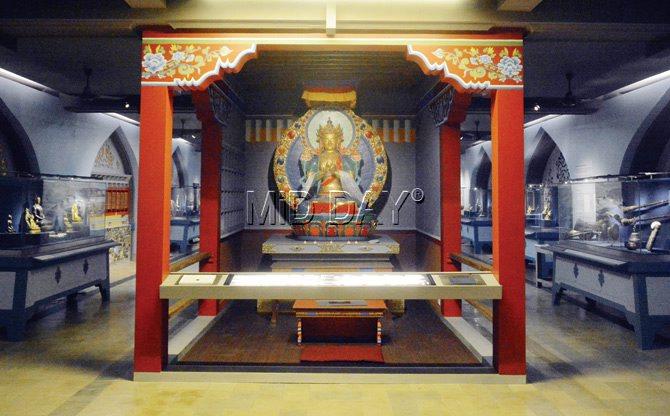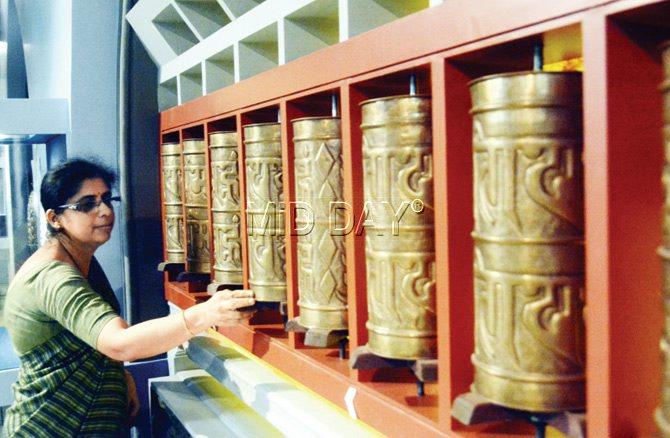After a year's worth of restoration, the Chhatrapati Shivaji Maharaj Vastu Sangrahalaya opens its Himalayan Art Gallery next month

The six-feet high seated image of Maitreya is made by clay sculptor Chhemet Rigzin and his team from Ladakh. It is placed inside a gompa-replica, and will have faux manuscripts and ceremonial objects beside it.
![]() A tantric trumpet fashioned from a human femur, samovars for making yak butter tea and chhaang (barley beer), and erotic yab-yum statues that depict the union of male compassion and female wisdom are just some of the highlights of the Himalayan Art Section at the Chhatrapati Shivaji Maharaj Vastu Sangrahalaya (CSMVS). The section, earlier called the Nepal and Tibetan section, closed to the public in May last year, and has undergone a year’s restoration and re-conceptualisation. On May 7, the gallery will be inaugurated by Ven. Geshe Lhakdor, director of the Library of Tibetan Works and Archives in Dharamshala, Himachal Pradesh.
A tantric trumpet fashioned from a human femur, samovars for making yak butter tea and chhaang (barley beer), and erotic yab-yum statues that depict the union of male compassion and female wisdom are just some of the highlights of the Himalayan Art Section at the Chhatrapati Shivaji Maharaj Vastu Sangrahalaya (CSMVS). The section, earlier called the Nepal and Tibetan section, closed to the public in May last year, and has undergone a year’s restoration and re-conceptualisation. On May 7, the gallery will be inaugurated by Ven. Geshe Lhakdor, director of the Library of Tibetan Works and Archives in Dharamshala, Himachal Pradesh.
 The six-feet high seated image of Maitreya is made by clay sculptor Chhemet Rigzin and his team from Ladakh. It is placed inside a gompa-replica, and will have faux manuscripts and ceremonial objects beside it. Pics/Bipin Kokate
The six-feet high seated image of Maitreya is made by clay sculptor Chhemet Rigzin and his team from Ladakh. It is placed inside a gompa-replica, and will have faux manuscripts and ceremonial objects beside it. Pics/Bipin Kokate
ADVERTISEMENT
The intimate gallery, which was originally set up in 1965 by SV Gorakshakar, then curator who became the director of the museum, now takes visitors through the rich tradition of Nepal, Leh, Ladakh and Tibet through the display of 140 objects (which include metal sculptures, manuscript folios and thankas), paintings, videos showing monastic life in Dharamshala, digital information panels and even an interactive set of prayer wheels. “We wanted to give a broader perspective of the Himalayan region and how it was influenced by various parts of Asia. The earlier gallery had no context,” said senior curator Vandana Prapanna.

Manisha Nene, assistant director, turns a set of prayer wheels at the gallery. The purpose is to make the gallery interactive and accessible to all kinds of visitors, some who may not have had a chance to visit Nepal or Leh
When mid-day visited the new section this week, we were greeted by an imposing six feet high seated statue of Maitreya, designed by clay sculptor Chhemet Rigzin and his team from Ladakh, using traditional techniques that incorporate the use of rags in the structure. “We took the style of gompas or temples in Leh to create this shrine,” said Prapanna.

Vandana Prapanna, senior curator, examines an 18th century statue of a mahasiddha, learned men with supernatural powers, who could stop the sun from moving or create a hailstorm at will, but only for the benefit of mankind
As Manisha Nene, assistant director, took us around, she said that rather than divide the space according to geographical regions, a theme-wise understanding of Buddhist and Hindu art was opted for. The gallery spatially borrows from vajrayana Buddhism, known for its extensive tantric practices, and will surely have many a visitor curious about the 11-headed and 1000 armed Avalokiteshvara or the 16th centuy CE gilt bronze sculpture of King Songtsen Gampo from Tibet, who was responsible for bringing Buddhism to Tibet.

Made from a human femur, this 18th century trumpet is used for tantric practices, unlike other instruments used for auspicious rituals

A late 19th century plaque household altar showing the Chintamani Avalokitesvara, made of crystal and encrusted with ivory and pearls.
A team of four — including resident artists Kishor Gaonkar and Siddhant Vaigankar, exhibition artist Prateek Aroskar and senior curatorial assistant Divya Pavathinal — headed by Prapanna and Nene, and a team of conservation artists — are behind this project. Sabyasachi Mukherjee, director of CSMVS, said, “Keeping globalisation in mind, it is important for museums to stay relevant in a changing world. Not many Indian museums have a collection of Himalayan art such as this, now significant after the earthquake in Nepal and the situation in Tibet.”
 Subscribe today by clicking the link and stay updated with the latest news!" Click here!
Subscribe today by clicking the link and stay updated with the latest news!" Click here!







